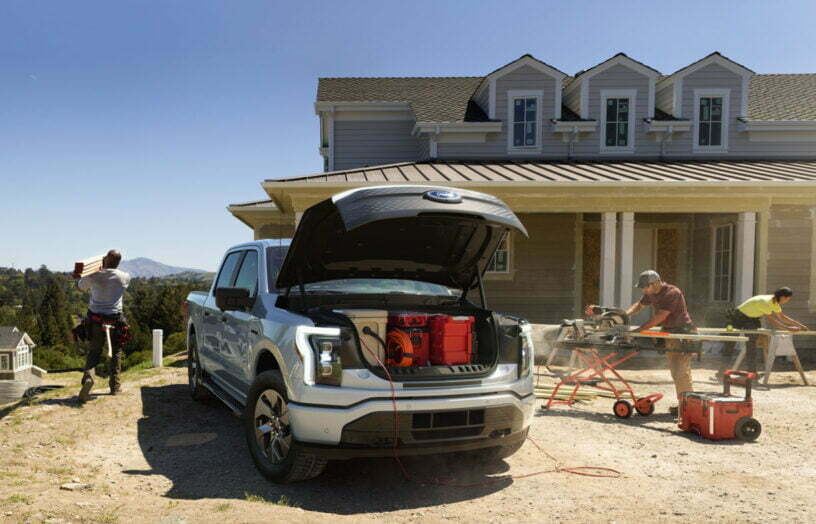Building a bigger backup

If you have critical systems that need to stay powered in a blackout, you need some sort of battery backup. Lance Turner describes his DIY system for supplying water without mains electricity.
Living in a semi-rural area, we have no town water available. The property has a bore that supplies water for all household water except drinking (the water is a bit too mineralised for drinking), and so requires water to be pumped to the house.
But what happens when there is no mains power, as seems to happen fairly regularly here?
When we first moved in, one of the first things I did was set up a backup water source consisting of a 2200L rainwater tank, a small pressure pump and a battery, 160W of solar panels and an inverter to power the pump. This system was primarily used to provide water for the chooks and other critters, as well as plants that couldn’t tolerate the bore water.
Because it was an independent system, when power went down I had to go out and switch it on and connect a hose between the rainwater pump and the house water supply. I also had to go out to the bore pump house to close the main water valve there to prevent backflow against the bore pump. I planned to get the little solar-powered pump permanently plumbed up one day, but that never happened, and because it was a rather kludged together system (that has worked perfectly for 12 years, mind you), I decided to put upgrades into the main water supply system instead.
The bore water supply to the house was originally derived from a big Davey 95 series deep well pump (the yellow and black pump in the photo) combined with a 100L pressure tank. However, having the bore pump turn on and off regularly was not ideal, as it draws around 1500W (with a massive startup surge that would cause the house lights to flicker), and constant cycling isn’t ideal for those sorts of pumps. Plus, with no power, we had no water except for the rainwater backup.
Upgrade number one
To make for a more robust system, about four years ago I made some changes to the setup. I did this in two stages (as the budget allowed). First, we installed a 6500L rainwater tank next to the bore pump house and redirected the bore pump into this tank via a float valve. The bore pump’s inbuilt pressure switch turns it off when the float valve closes as the tank fills, and the 100L pressure tank means the bore pump only cycles once or twice during the half hour runtime, unless there is a large water drawoff at that time. The bore pump simply keeps the tank filled, providing a week or two’s water reserve—plenty should we have an extended outage.
To provide pressurised water to the house, we added a DAB EsyBox Mini variable speed pressure pump. These are fantastic little pump/controller systems that can supply up to 80 litres a minute, but only draw the power necessary to provide the flow and pressure demanded. When running, it usually only draws a few hundred watts.
To finish this part of the upgrade, I fitted a power panel (top left in the photo at left) which has an isolator switch for each pump, along with a four-slot breaker box containing an RCBO (combined overload and earth leakage circuit breaker) and a 24-hour timer and separate 40A contactor for the bore pump (the bore pump has a high startup surge requirement that can wear out the 16A timer contacts, so the contactor is treated as expendable as it is cheaper and easily replaced. But after four years, and around 1500 pump starts, there are no signs of issues). The bore pump timer is set to operate for just half an hour each day at around midday, to make best use of our spare solar energy. This has proven more than enough runtime to keep the 6500L tank full.

Stage two
But, this still didn’t solve our problem of no water when the power was down. I wanted a system that simply operated with no effort on our part, so that no trips to the pump house were required.
Obviously, I needed a UPS (uninterruptible power supply) system of some sort. The simplest solution would have been a computer UPS, but the main issue with these is a short runtime, as they have quite small batteries. Those with longer runtimes and higher capacity batteries are usually stupidly expensive, and most are not water resistant.
Being the DIY type, I wanted to put together a system, so I started looking around for UPS type inverter/chargers. After finding a few low cost units direct from China, I decided on one supplied locally. As luck would have it, Excelsior Power (inverter.com.au) had a 1000W inverter/charger unit with inbuilt changeover switch (model IC1000/12) for $499 including shipping. This was the ideal unit, and just required a connection to a suitable battery, with the mains power connections being done via plugs.
As the unit wasn’t water resistant, I fitted the inverter inside a steel powder-coated electrical enclosure measuring 500 x 400 x 150mm, bought from online store Vevor (vevor.com.au), as they have a good range of these units at decent prices. These boxes come with all required hardware and, being made from 1.5mm steel, are built like a tank, with an IP66 rating (depending on how you connect to them, of course).
I fitted the inverter and a 150A circuit breaker/isolator (bought directly from China) into the box, and added the appropriate battery cables, also bought directly from China from a store that supplies silicone cased cables pre-terminated with the cable lugs of your choice (mucg.aliexpress.com). The inverter actually came with cables, but they were too short (I needed around a metre of cable length) and not heavy enough gauge for this inverter, which has a 2000W surge capacity.
To finish off the box, I added a waterproof mains inlet socket (like those used on caravans) as well as an outlet socket (a single outdoor rated power point). Both of these were wired back to the inverter using appropriate cables. I also fitted rubber grommets into the removable plate in the bottom of the case to pass the battery cables through.
A battery needed
Of course, to power the inverter, we also needed a battery. I ordered a 12V, 100Ah lithium iron phosphate (LiFePO4) unit from Rockby Electronics (rockby.com.au), one of Australia’s best electronic component stores, as they also have other gear like solar panels and batteries, and these regularly go on sale. At $377, it was a pretty good price.
| Inverter | $499 |
| Enclosure | $150 |
| Inlet socket | $33 |
| Outlet socket | $14 |
| Circuit breaker | $25 |
| Battery cables | $57 |
| Battery | $377 |
| Battery box | $49 |
| Assorted bits and bobs | $10 |
| Total | $1214 |
The last piece of the puzzle was a battery box for the new battery. I ended up using a Projecta BPE330 unit from ebay as it was the simplest option with the basic features I needed and provided adequate weather protection, given the battery was inside the pump house along with everything else.

Final setup
So, with everything assembled, it was just a matter of installing the various bits into the pump house.
I screwed the inverter enclosure onto the inside wall of the pump house, next to the breaker box board. A short extension cord jumpers the mains outlet on the breaker board to the inverter’s mains power inlet socket, while the DAB pump plugs into the inverter box’s outlet power point.
The battery was fitted into the battery box, which was simply placed onto a board on the ground below the inverter box, and the inverter cables connected to the output terminals on the battery box.
I then turned on power to the inverter and checked it was charging the battery correctly (I had already tested the inverter operation in the workshop while assembling the system).
Next came the main test, which was to turn on power to the DAB pump and ensure it was running from the mains, and then to turn off mains power to the inverter box and ensure that the inverter continued to power the pump from the battery. This all worked flawlessly, the only issue being that the DAB pump does a quick reset when the power changes over, as the inverter is not as fast to change over as a typical computer UPS. This means that, when mains power goes down, there is around a four second delay before the pump will be ready to supply water again.
Real world test
All of the stage two work was done in the middle of 2024, and it wasn’t until January 2025 that we got to test the system in a power outage. TasNetworks was replacing the main transformer and pole to our local area while doing upgrades, and the power was off for around eight hours. During that time, the system worked perfectly as if still on mains power.
So, now, we have a water supply system that should run for several days should an extended outage occur (it has before in this area, after severe storms in 2009). Of course, this sort of system can be used pretty much anywhere a robust, reliable and easily repaired UPS is needed.
Why DIY?
The advantage of a system assembled yourself is that all of the components are separate and can be replaced individually, rather than having to replace an entire expensive commercial UPS should a single failure occur. Of course, battery capacity of the system can also be expanded simply by just swapping in a higher capacity battery.
So, what did all this cost? Well, not nearly as much as a commercial 1000W UPS with this much storage. Total cost was just over $1200, with an itemised list below. Almost all of the items I bought online included free shipping, including the inverter, sockets, battery box and battery cables, while shipping is included in the stated price of the enclosure.
Further reading
 ReNew
ReNew
Simple and cheap composting loo
A composting loo lets you save huge amounts of water each year from toilet flushing, and can extend the life of an old septic by removing most of the solid waste load. Spud Murphy describes a popular design used for decades.
Read more DIY
DIY
Bring on the electric ute
Bryce Gaton asks, will 2023 be the Australian ‘Year of the electric light commercial vehicle’?
Read more


